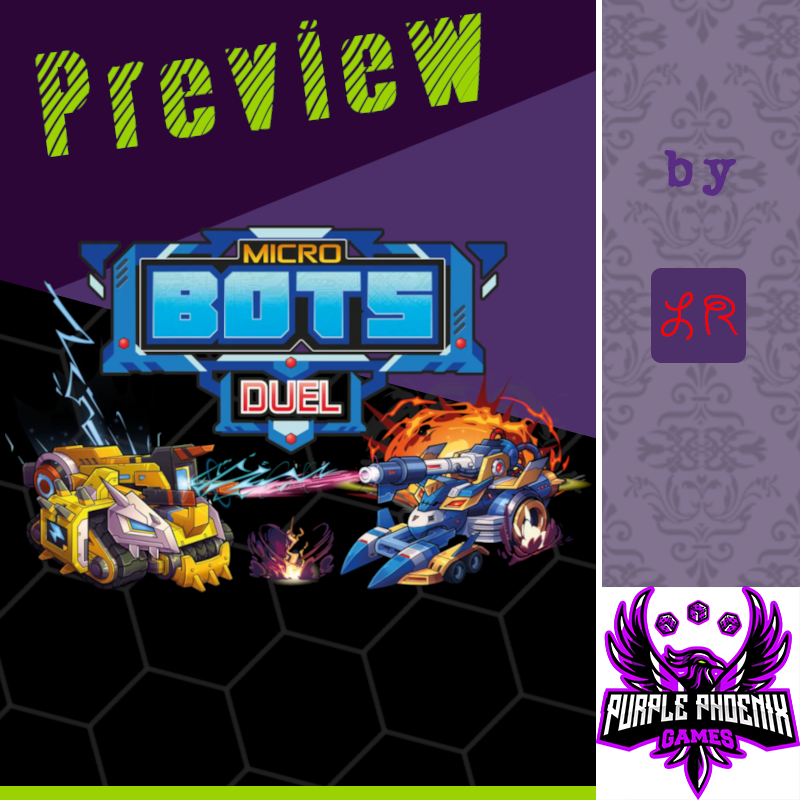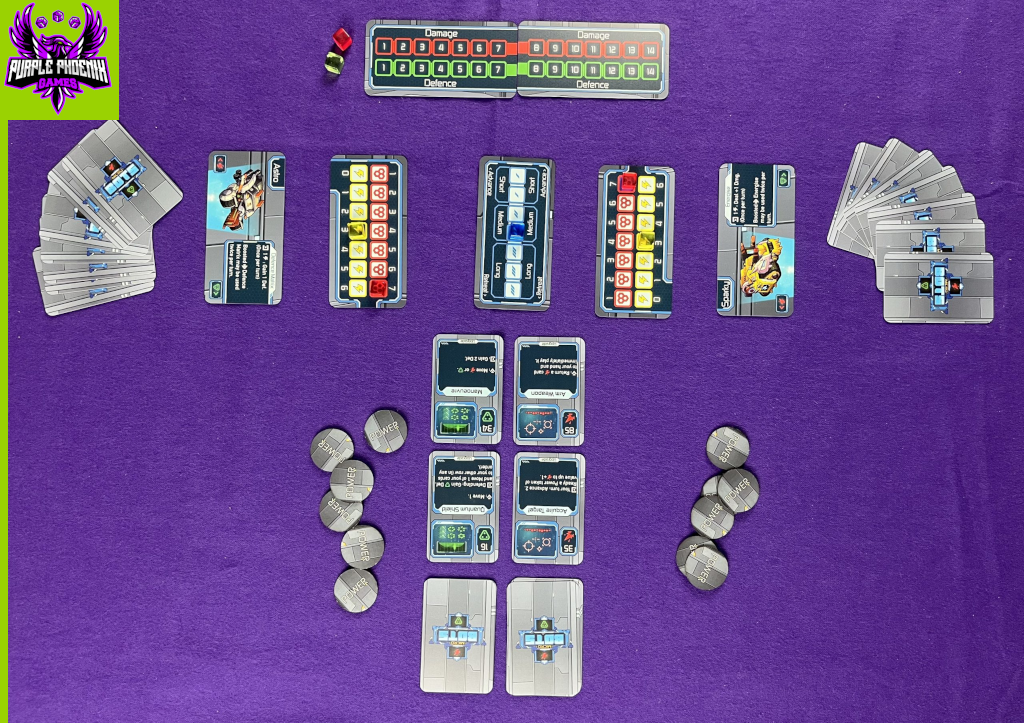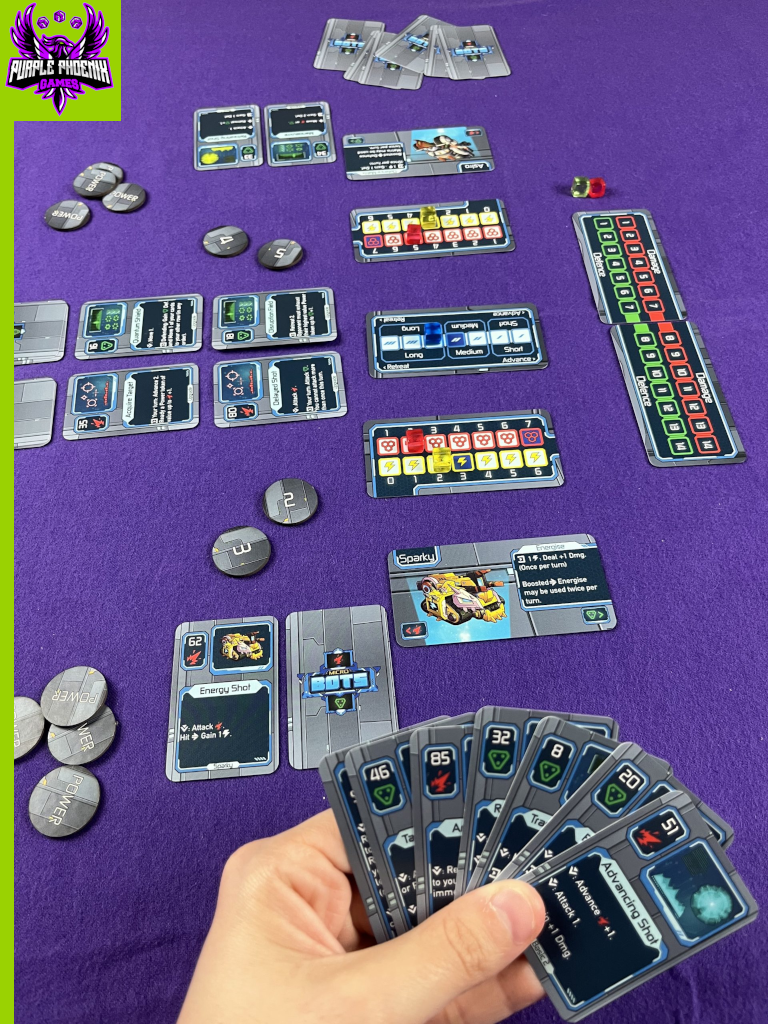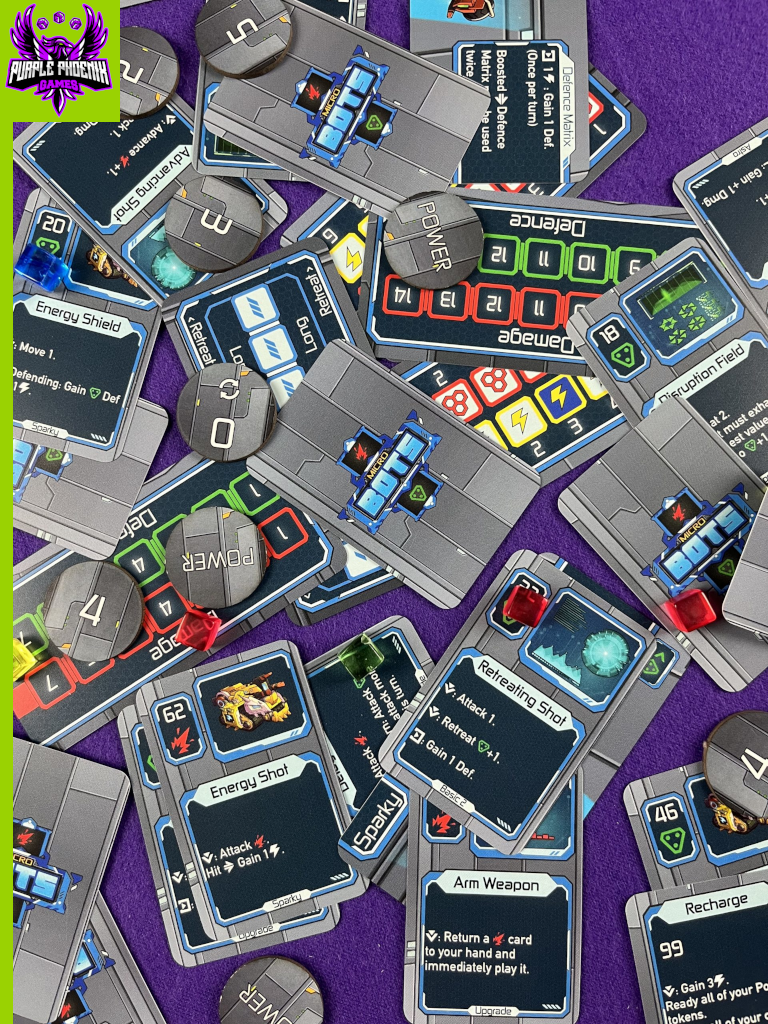
A while ago I backed a game on Kickstarter called Micro Dojo. I loved it so much that when the expansion hit Kickstarter, I knew I had to have it. And then one day in an update, Prometheus Game Labs mentions another game they’ve got in the works, and that they were about ready to send it out to reviewers. So I decided to shoot my shot and reached out to them! I couldn’t wait to see what they were developing, and was ecstatic when they agreed to share their newest game with us at Purple Phoenix Games. So without further ado, take a peek at their latest project, Micro Bots Duel.
| Micro Bots Duel (2023) | Prometheus Game Labs |
| 2 players | 15-45 minutes |
| Ages 14+ | BGG Weight – Not yet available |
Disclaimer: We were provided with a prototype copy of Micro Bots Duel for the purposes of this preview. What you see pictured below may not be an exact match to the finalized production version. -L
Micro Bots Duel is a competitive game of strategy and hand management for 2 players. Each player takes on the role of a unique Bot who has entered battle, in hopes of depleting its opponent’s armor down to zero. Played over a series of rounds, players will be taking turns playing cards, performing Actions, and engaging in Combat, until one player’s Bot has no armor left. To set up for a game, place the Range Tracker in the center of the table, with a cube on the starting space. Give each player a Status Tracker card (denoting Armor and Energy) and cubes to place on their corresponding starting spaces. Place the Combat Tracker and matching cubes to the side of the play area. Shuffle the Upgrade cards in their separate decks, and reveal 2 cards from each deck face-up next to the play area. The remaining Upgrade cards create draw decks. Each player chooses a Bot and takes its corresponding Bot card and 4 Bot Action cards. Each player also receives a set of 3 Basic Action cards and 6 Power Tokens. The setup for a game should look like the picture below.

The game is played in rounds, and each round is broken down into 2 phases: Planning Phase and Action Phase. To start the Planning Phase, each player will choose a card from their hand to be played this round. Cards are chosen in secret, and are placed face-down on the table. When both players have selected their card, they are simultaneously revealed, and the first player for the round is determined. All cards have an Initiative Number, and the player whose card has the lower Initiative gets to act first in the Action Phase.
The Action Phase is broken down into 3 steps. Action Cards are categorized into Weapon cards and Support cards, and the type of card you play affects your first step of the Action Phase. Depending on which type of card played, you must then place it to the matching row by your Bot card. Weapon cards go to the left, and Support cards to the right. A small bit of housekeeping to start this phase, as their placements could affect your later actions.
Step 2 is to resolve your played card Abilities. Some Abilities are Instant Actions, and take effect the turn the card is played. Others are Held Actions and can be saved for later turns. Some Actions require you to spend Energy to activate them, while some have Conditional Effects, meaning you can only perform the Action if the printed condition has been met. It is important to note that all Actions are optional, but they must be resolved from top to bottom in order. Once all Actions on a card have been used (or skipped), you flip the card face-down. In essence, all Actions fall into 3 categories: Attack, Defend, or Move the Range marker. Attacking lets you to attack your opponent. Defending Actions are usually Held, and are used during Combat to boost your overall Defense. Moving the Range marker in certain directions affects Combat.
The last step of the Action Phase is to Upgrade. At the end of your turn, you may choose to spend 1 Energy to buy an Upgrade card. These cards go directly into your hand, and can be used immediately on your next turn. After purchasing an Upgrade card (or choosing not to), your turn ends, and the next player may act.
The crux of the game is in Combat. Once an Attack Action has been activated, you and your opponent sort of pause the Action Phase and perform a Combat. To begin a Combat, you first determine the starting Damage and Defense values – Damage is stated on the played Action card and Defense depends on where the cube sits on the Range Tracker. Once those initial amounts are determined, players get the opportunity to boost their side. Each player secretly selects a Power Token from their supply, and reveal them simultaneously. Add the values of the Power Tokens to the corresponding sides for each player. The players now get to take turns using Held Actions, in hopes that they can boost their side of the Combat values. This part goes back and forth (Attacker, then Defender) until both players have passed on using Held Actions. Now take a look at the final Damage and Defense values. If the Damage is higher than the Defense, the Defending player takes Damage to their Armor equal to the difference between the two values. If the Defense value is higher, then the Attack is considered a Miss, and no Damage is taken.
Once a Combat has been completed, resume the Action Phase where you left off. The game continues in this fashion until one player’s Bot Armor has been depleted to zero. That player’s Bot has sustained too much damage, and the surviving Bot is declared the winner!

So what do I think of Micro Bots Duel? I have to admit that at first, the gameplay felt a little clunky. The different kinds of Actions confused me a bit, and the way that Combat plays out seemed long-winded. But the more I play, the more comfortable I have become with the gameplay, and it feels pretty smooth and seamless to me now. I wouldn’t necessarily say this is a heavy game, but it does have more moving parts than you might be expecting for such a small game (table-presence-wise). It definitely offers tons of strategy, as you have to try to outmaneuver your opponent. You have to be able to adapt on the fly, as each round starts with revealing your chosen cards simultaneously. You can’t really plan in advance what to do, as you don’t know what your opponent has picked ahead of time. You pick at the same time, and have to hope that your chosen Action card can withstand whatever your opponent has chosen this round. Like I said, I think there’s a bit of a learning curve, but once you get past it, the game plays well and is lots of fun!
As with Micro Dojo, Prometheus Game Labs is packaging Micro Bots Duel in a small and minimalistic way – this time in a mint tin! It makes it a great size to take with you wherever you go. The copy you see pictured here is a prototype copy, but the components are great quality. The cardboard Power Tokens and the colored cubes are nice and chunky. The cards are made from PVC and are sturdy and feel good in hand. I’m interested to see how they adjust the components in the finalized production copies, but I would say this prototype is pretty high quality already.
Micro Bots Duel has an expansion already created and ready to go, called Power Up!. The expansion adds a new element in Power Up cards that allow players to take more powerful actions when they are activated. Each Bot also gets a unique Wildfire card that provides extra special abilities not found on any other type of Upgrade card. There are a few other neat additions and adaptations to the Micro Bots Duel gameplay, but I’ll keep those a surprise – you’ll have to try it for yourself! But I do have to say, the expansion heightens the gameplay.
If you’re looking for a solid 2-player game that is heavy enough to be challenging, but not so heavy that it’s a real brain-burner, I would highly recommend Micro Bots Duel. It hits Kickstarter here in February, so be on the lookout! Don’t let the size fool you – this game packs quite a punch!

